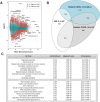This is a preprint.
Cytotoxic lymphocytes are dysregulated in multisystem inflammatory syndrome in children
- PMID: 32909006
- PMCID: PMC7480058
- DOI: 10.1101/2020.08.29.20182899
Cytotoxic lymphocytes are dysregulated in multisystem inflammatory syndrome in children
Update in
-
Downregulation of exhausted cytotoxic T cells in gene expression networks of multisystem inflammatory syndrome in children.Nat Commun. 2021 Aug 11;12(1):4854. doi: 10.1038/s41467-021-24981-1. Nat Commun. 2021. PMID: 34381049 Free PMC article.
Abstract
Multisystem inflammatory syndrome in children (MIS-C) presents with fever, inflammation and multiple organ involvement in individuals under 21 years following severe acute respiratory syndrome coronavirus 2 (SARS-CoV-2) infection. To identify genes, pathways and cell types driving MIS-C, we sequenced the blood transcriptomes of MIS-C cases, pediatric cases of coronavirus disease 2019, and healthy controls. We define a MIS-C transcriptional signature partially shared with the transcriptional response to SARS-CoV-2 infection and with the signature of Kawasaki disease, a clinically similar condition. By projecting the MIS-C signature onto a co-expression network, we identified disease gene modules and found genes downregulated in MIS-C clustered in a module enriched for the transcriptional signatures of exhausted CD8 + T-cells and CD56 dim CD57 + NK cells. Bayesian network analyses revealed nine key regulators of this module, including TBX21 , a central coordinator of exhausted CD8 + T-cell differentiation. Together, these findings suggest dysregulated cytotoxic lymphocyte response to SARS-Cov-2 infection in MIS-C.
Conflict of interest statement
Conflicts of interest statement
S.G. reports consultancy and/or advisory roles for Merck, Neon Therapeutics and OncoMed and research funding from Bristol-Myers Squibb, Genentech, Immune Design, Agenus, Janssen R&D, Pfizer, Takeda, and Regeneron.
Figures





References
-
- American Academy of Pediatrics and the Children’s Hospital Association (2020). Children and COVID-19: State Data Report.
-
- Barturen G., Babaei S., Català-Moll F., Martínez-Bueno M., Makowska Z., Martorell-Marugán J., Carmona-Sáez P., Toro-Domníguez D., Carnero-Montoro E., Teruel M., et al. (2020). Integrative Analysis Reveals a Molecular Stratification of Systemic Autoimmune Diseases. medRxiv 2020.02.21.20021618. - PubMed
-
- Beltra J.-C., Manne S., Abdel-Hakeem M.S., Kurachi M., Giles J.R., Chen Z., Casella V., Ngiow S.F., Khan O., Huang Y.J., et al. (2020). Developmental Relationships of Four Exhausted CD8 T Cell Subsets Reveals Underlying Transcriptional and Epigenetic Landscape Control Mechanisms. Immunity 52, 825–841.e8. - PMC - PubMed
Publication types
Grants and funding
LinkOut - more resources
Full Text Sources
Research Materials
Miscellaneous
